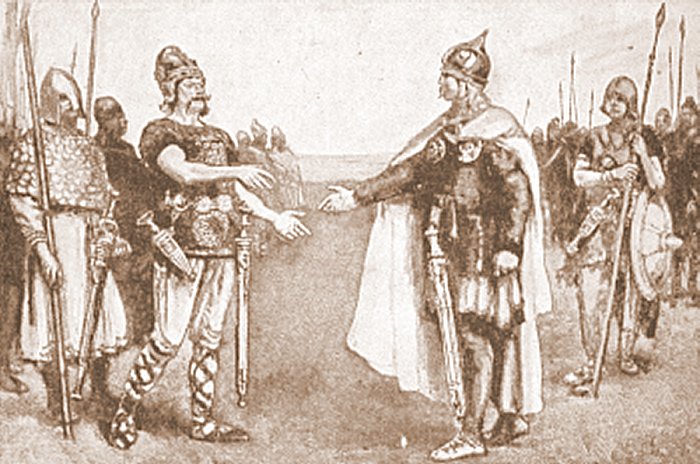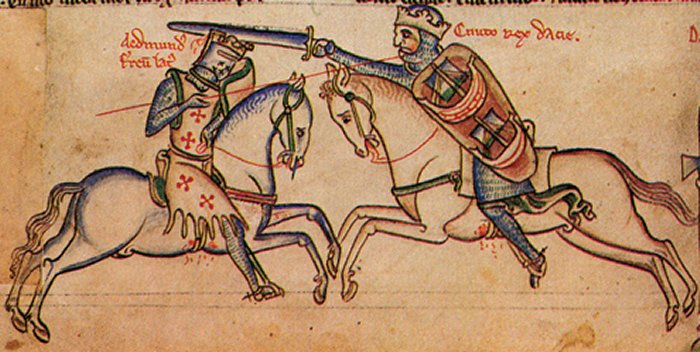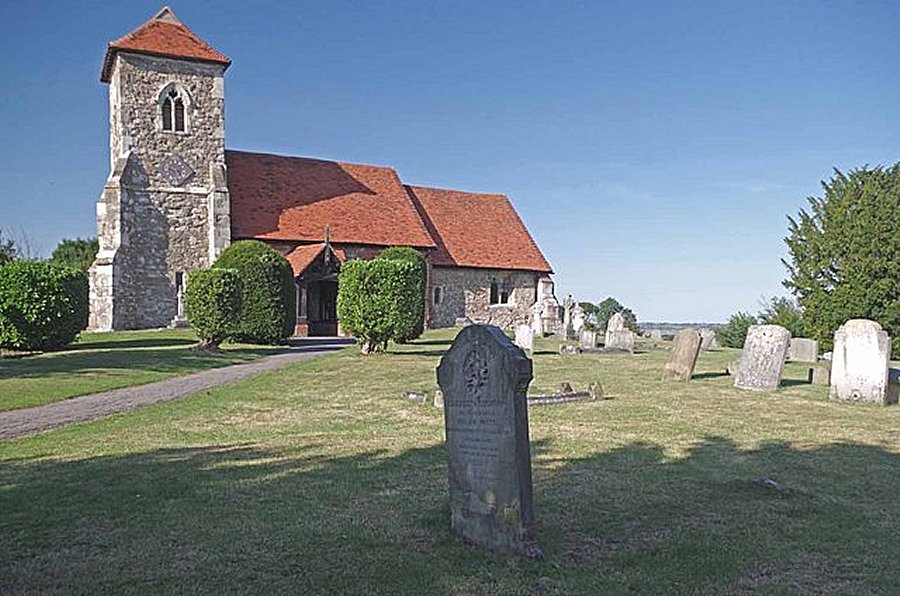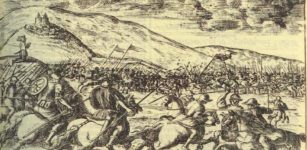Battle Of Assandun: The Great Battle In English History And A Brief Period Of Viking Dominion In England
A. Sutherland - AncientPages.com - The Battle of Assandun was an important historical event that gave Canute the Great (Cnut Knut den Store) the Crown of England.
 Edmund II Ironside and Canute the Great after Battle of Assandun.
Edmund II Ironside and Canute the Great after Battle of Assandun.
It took place on October 18, 1016, and was fought between Danish armies led by Canute the Great and the English army led by King Edmund II ('Ironside').
"Then he [Edmund] assembled his troops the third time, and they went to London, all north of the Thames, and looked out through Clayhanger, and he freed the populace and drove the enemy to their ships. It was within two nights after the king passed over at Brentford, where he fought the enemy and put them to flight: but there were many Englishmen who were drowned by their own carelessness; who had gone before the army to plunder…" (Anglo-Saxon Chronicle)
The battle was victorious for the Danes and helped them to retake the English territories. For many years, historians have argued in a way that unforunately does not give or have a result regarding the location of this critical battle and whether it took place.
Was Assandun – Ashdon, near Saffron Walden in north Essex, or Ashingdon near Rochford in southeast Essex, England?
After the battle, Edmund had to sign a treaty with Canute. By this treaty, all England except Wessex would be controlled by Canute. Additionally, if one of the kings should die, the other would take all of England, that king's son being the heir to the throne.
Edmund died on November 30, and Canute the Great assumed control of his territories. He was crowned King of England in January 1017.
 Edmund Eisenseite (left) in a duel with Knut the Great. (Representation from the Chronica Majora by Matthew Paris, around 1250). Image credit: Matthew Paris (1200–1259) - Public Domain
Edmund Eisenseite (left) in a duel with Knut the Great. (Representation from the Chronica Majora by Matthew Paris, around 1250). Image credit: Matthew Paris (1200–1259) - Public Domain
Thus for the first time, England became a single united kingdom, covering the same territory as it does today.
It also remained under Danish rule for the next 26 years.
Canute built a church, chapel, or similar holy site after winning a battle to commemorate the soldiers who died in battle.
A few years later, in 1020, the completion took the place of the memorial church known as Ashingdon Minster on the hill next to the presumed site of the battle in Ashingdon.
"King Canute ordered St Andrew's, "a church built of lime and stone for the souls of those slain in the Battle of Assandune 1016. It was dedicated in 1020 at a ceremony that King Canute and his officers attended. This battle was the decisive military encounter for the throne of England. Much of the church is now a 13C rebuild with a 14C tower. The rubble walls contain Roman tiles, and there are Saxon timbers in the tower."
 St Andrews Minster Ashingdon. There has been a church here since 1020. King Canute ordered its construction and attended the dedication. Much of the church was rebuilt in the Middle Ages. Image credit: © Copyright Glyn Baker and licensed for reuse under this Creative Commons Licence.
St Andrews Minster Ashingdon. There has been a church here since 1020. King Canute ordered its construction and attended the dedication. Much of the church was rebuilt in the Middle Ages. Image credit: © Copyright Glyn Baker and licensed for reuse under this Creative Commons Licence.
The church still stands to this day and is dedicated to Saint Andrew but is believed previously to have been dedicated to Saint Michael, who was considered a military saint: churches dedicated to him are frequently located on a hill.
Suppose Ashington was not the place of the battle. In that case, there is another possible location based on archaeological finds. Its location is Ashdon in the Essex area, where archaeologists unearthed Roman and Anglo-Saxon coins.
Written by – A. Sutherland - AncientPages.com Senior Staff Writer
Updated on January 21, 2024
Copyright © AncientPages.com All rights reserved. This material may not be published, broadcast, rewritten or redistributed in whole or part without the express written permission of AncientPages.com
Expand for referencesReferences:
More From Ancient Pages
-
 On This Day In History: Antonio Neri Was Born in Florence, Italy – On Feb 29, 1838
On This Day In History | Feb 29, 2020
On This Day In History: Antonio Neri Was Born in Florence, Italy – On Feb 29, 1838
On This Day In History | Feb 29, 2020 -
 Largest And Most Complete Ancient Egyptian Workshops Found In Saqqara
Archaeology | May 28, 2023
Largest And Most Complete Ancient Egyptian Workshops Found In Saqqara
Archaeology | May 28, 2023 -
 A Great Flood Destroyed The Mysterious Ancient City Of Petra – Evidence Has Been Found
Archaeology | May 12, 2017
A Great Flood Destroyed The Mysterious Ancient City Of Petra – Evidence Has Been Found
Archaeology | May 12, 2017 -
 Medici Family – Powerful Renaissance Godfathers And Patrons Of Galileo Galilei
Featured Stories | Dec 17, 2018
Medici Family – Powerful Renaissance Godfathers And Patrons Of Galileo Galilei
Featured Stories | Dec 17, 2018 -
 Ancient City Of Metropolis: Ruins With Traces Of The Hittites, Hellenistic, Roman, Byzantine And Ottoman Empires
Archaeology | Jan 8, 2018
Ancient City Of Metropolis: Ruins With Traces Of The Hittites, Hellenistic, Roman, Byzantine And Ottoman Empires
Archaeology | Jan 8, 2018 -
 Abundantia: Roman Goddess Who Was Shaking Her Gifts From Cornucopia – ‘Horn Of Plenty’
Featured Stories | Nov 4, 2019
Abundantia: Roman Goddess Who Was Shaking Her Gifts From Cornucopia – ‘Horn Of Plenty’
Featured Stories | Nov 4, 2019 -
 On this day in history: The Battle of the Frigidus – Sep 5, 394 AD
News | Sep 5, 2015
On this day in history: The Battle of the Frigidus – Sep 5, 394 AD
News | Sep 5, 2015 -
 On This Day In History: The Gregorian Calendar Implemented – On Oct 5, 1582
News | Oct 5, 2016
On This Day In History: The Gregorian Calendar Implemented – On Oct 5, 1582
News | Oct 5, 2016 -
 Pan Twardowski – The Man Who Sold His Soul To The Devil In Exchange For Special Powers
Featured Stories | Aug 12, 2021
Pan Twardowski – The Man Who Sold His Soul To The Devil In Exchange For Special Powers
Featured Stories | Aug 12, 2021 -
 Secret Tunnels Used By Knights Templar Leading To The Treasure Tower – Discovered
Archaeology | Oct 29, 2019
Secret Tunnels Used By Knights Templar Leading To The Treasure Tower – Discovered
Archaeology | Oct 29, 2019 -
 What Is The History Of Pancakes?
Ancient History Facts | Mar 7, 2024
What Is The History Of Pancakes?
Ancient History Facts | Mar 7, 2024 -
 Deception And Hidden Truth – Ancient Struggle Of The Eagle And Serpent – Part 1
Ancient Mysteries | Sep 4, 2019
Deception And Hidden Truth – Ancient Struggle Of The Eagle And Serpent – Part 1
Ancient Mysteries | Sep 4, 2019 -
 Something Never-Before-Seen Is Hidden Beneath 15 Giant Viking Burial Mounds Spotted By Radar In Norway
Archaeology | Jan 19, 2021
Something Never-Before-Seen Is Hidden Beneath 15 Giant Viking Burial Mounds Spotted By Radar In Norway
Archaeology | Jan 19, 2021 -
 Mysterious Ancient Falicon Pyramid And Its Complex Obscure History
Featured Stories | Nov 28, 2018
Mysterious Ancient Falicon Pyramid And Its Complex Obscure History
Featured Stories | Nov 28, 2018 -
 Unique Belongings Of Bronze Age Warrior Offer Evidence Of Massive Violent Conflict In Europe
Archaeology | Oct 18, 2019
Unique Belongings Of Bronze Age Warrior Offer Evidence Of Massive Violent Conflict In Europe
Archaeology | Oct 18, 2019 -
 Aegir – Jotun Lord Of The Stormy Seas Revered And Feared By Norsemen
Featured Stories | Sep 6, 2019
Aegir – Jotun Lord Of The Stormy Seas Revered And Feared By Norsemen
Featured Stories | Sep 6, 2019 -
 Vainamoinen – Sage, Sorcerer, Adventurer And Friend Of Ilmarinen In Kalevala Myths And Legends
Featured Stories | Nov 16, 2018
Vainamoinen – Sage, Sorcerer, Adventurer And Friend Of Ilmarinen In Kalevala Myths And Legends
Featured Stories | Nov 16, 2018 -
 Tír na nÓg – Mythical Land Where Time Floats Slower Than In Mortal Lands
Celtic Mythology | Mar 2, 2020
Tír na nÓg – Mythical Land Where Time Floats Slower Than In Mortal Lands
Celtic Mythology | Mar 2, 2020 -
 Unusual 300,000-Year-Old Jawbone May Belong To An Unknown Vanished Human Lineage
Archaeology | Dec 18, 2023
Unusual 300,000-Year-Old Jawbone May Belong To An Unknown Vanished Human Lineage
Archaeology | Dec 18, 2023 -
 New Cosmic Ray Bombardment Of The Great Pyramid – Search For The Hidden Chamber Continues
Archaeology | Jan 20, 2020
New Cosmic Ray Bombardment Of The Great Pyramid – Search For The Hidden Chamber Continues
Archaeology | Jan 20, 2020
